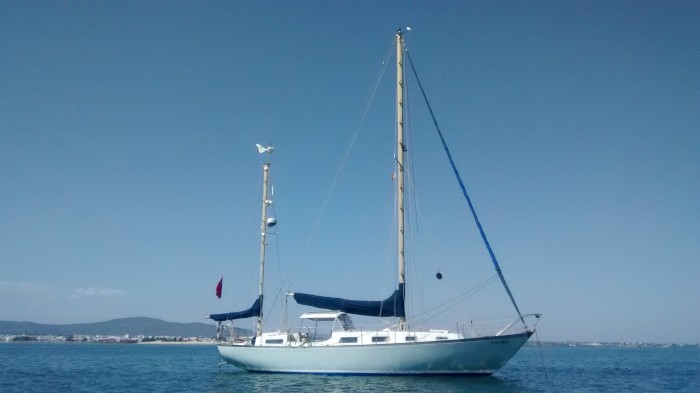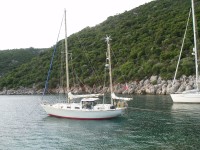
Singlehanded aboard Salara
02 December 2021 | Spain
12 November 2021 | Spain
31 October 2021 | Spain
29 September 2021 | Spain
08 July 2021 | Portugal
08 November 2020 | Portugal
31 July 2020 | Portugal
05 April 2020 | Portugal
16 November 2019 | Portugal
14 October 2019 | Spain
07 October 2019 | Spain
13 September 2019 | Spain
03 September 2019 | Spain
17 July 2019 | Spain
21 June 2019 | Spain
17 May 2019 | Spain
08 November 2018 | Portugal
26 October 2018 | Spain
26 September 2018 | Spain
23 August 2018 | Balearic Islands, Spain.
Launch off 2015
28 May 2015 | Culatra, Ria Formosa, Portugal
Peter

I left Gatwick to return to Portugal during the third week of March finally escaping from the last of the UK winter and pleased to be once again heading for the sunshine. I was to be disapointed as when my Easyjet flight touched down at Faro Airport it was raining hard. The taxi dropped me at the boatyard and by the time I had walked to ‘Salara`, found a ladder and climbed aboard I was soaked. Even so I was pleased to be back in the familiar cabin which has been my home for almost twenty years now.
After changing into some dry clothes the first job to do was to connect to the electrical supply and make a cup of tea. While waiting for the rain to stop I went over the list of maintenance that needed to be carried out before ´Salara´ could be launched off. This list was to say the least fairly long.
I had started to scrape the old antifouling from the hull before I left for the UK so that was my first task and not one that I was looking forward to. It is a dirty, slow and tedious job to remove seven years worth of dead antifouling, the last time I did this was just before I left Lymington to go long term cruising. I used a 25mm chisel as a scraper rather than an electric sander as most other people do. In my experience a scraper does not create as much dust and the resulting debris is easier to clear up after each session. I did two or three hours every morning and then went for a shower. Working to this system I did the whole hull in two weeks.
Once down to the original epoxy coating I could see where further attention was required so that kept me busy filling and sanding down for quite some days. Each time I thought I had finished I would find another small blister that had to be eradicated.
I was eventually in a position to give her a coat of underwater primer. I had removed the old red boot top stripe and replaced it in white while raising the waterline an inch or so. While I was motivated I also removed the gold cove line stripe on the topsides which was plastic tape and had suffered severe sun damage. The old adhesive was a nightmare to remove. I shall probably repaint it in white at a later date.
In between times I had attacked all the other jobs on my list which were many and varied. I had spent hours trying to repair the old Johnson outboard motor which I use on the dinghy but finally I had to admit defeat and order a new Suzuki 2.5hp motor from UK. It arrived within ten days at a total cost of 550 UK pounds inclusive of carriage.
I engaged a contractor to make some new upholstery for the main cabin and also to replace the plastic windows in the cockpit screens which had been damaged by the sunlight. All these jobs take time and one week quickly runs into next week. This boatyard is full of yachties who are all feverishly working on their boats. People stop by and look at what you are doing, all offer helpful advice or tell you that you are doing it wrong. For my part I agree with everyone and carry on doing things in my own way confident that it is correct. Even so it is amazing how many differing viewpoints there are.
I had arranged a launch off date for the 14 May so a week before that I applied two coats of blue antifouling in readiness. Unfortunately my three year old laptop suddenly decided it had had enough and seriously crashed, it would cost 300 euros to repair so it was financially sound to buy a new one. I therefore had to postpone my launch date until I could organise a replacement. That turned into a whole new saga which I shall not bore you with, suffice to say that it is not as easy as it sounds. I got one sorted eventually and organised a launch off for the 25 May. It happened to be during a period of neap tides but I reckoned there would just about be enough depth of water to get Salara into the main channel.
There was no way that I wanted to pay yet another week of boatyard fees as Salara had been in the yard for seven months.
On launch day she was lowered into the water, the engine started immediately and I eased her out of the hoist bay, it was absolute high water but the keel scraped in the soft muddy bottom several times before she gained the main channel and I steered her towards the sea to anchor in six metres depth in the lee of Culatra Island. I spent the rest of the day attending to some final preparation and soon Salara was once again ready for a summer of cruising and I was a happy man.
After changing into some dry clothes the first job to do was to connect to the electrical supply and make a cup of tea. While waiting for the rain to stop I went over the list of maintenance that needed to be carried out before ´Salara´ could be launched off. This list was to say the least fairly long.
I had started to scrape the old antifouling from the hull before I left for the UK so that was my first task and not one that I was looking forward to. It is a dirty, slow and tedious job to remove seven years worth of dead antifouling, the last time I did this was just before I left Lymington to go long term cruising. I used a 25mm chisel as a scraper rather than an electric sander as most other people do. In my experience a scraper does not create as much dust and the resulting debris is easier to clear up after each session. I did two or three hours every morning and then went for a shower. Working to this system I did the whole hull in two weeks.
Once down to the original epoxy coating I could see where further attention was required so that kept me busy filling and sanding down for quite some days. Each time I thought I had finished I would find another small blister that had to be eradicated.
I was eventually in a position to give her a coat of underwater primer. I had removed the old red boot top stripe and replaced it in white while raising the waterline an inch or so. While I was motivated I also removed the gold cove line stripe on the topsides which was plastic tape and had suffered severe sun damage. The old adhesive was a nightmare to remove. I shall probably repaint it in white at a later date.
In between times I had attacked all the other jobs on my list which were many and varied. I had spent hours trying to repair the old Johnson outboard motor which I use on the dinghy but finally I had to admit defeat and order a new Suzuki 2.5hp motor from UK. It arrived within ten days at a total cost of 550 UK pounds inclusive of carriage.
I engaged a contractor to make some new upholstery for the main cabin and also to replace the plastic windows in the cockpit screens which had been damaged by the sunlight. All these jobs take time and one week quickly runs into next week. This boatyard is full of yachties who are all feverishly working on their boats. People stop by and look at what you are doing, all offer helpful advice or tell you that you are doing it wrong. For my part I agree with everyone and carry on doing things in my own way confident that it is correct. Even so it is amazing how many differing viewpoints there are.
I had arranged a launch off date for the 14 May so a week before that I applied two coats of blue antifouling in readiness. Unfortunately my three year old laptop suddenly decided it had had enough and seriously crashed, it would cost 300 euros to repair so it was financially sound to buy a new one. I therefore had to postpone my launch date until I could organise a replacement. That turned into a whole new saga which I shall not bore you with, suffice to say that it is not as easy as it sounds. I got one sorted eventually and organised a launch off for the 25 May. It happened to be during a period of neap tides but I reckoned there would just about be enough depth of water to get Salara into the main channel.
There was no way that I wanted to pay yet another week of boatyard fees as Salara had been in the yard for seven months.
On launch day she was lowered into the water, the engine started immediately and I eased her out of the hoist bay, it was absolute high water but the keel scraped in the soft muddy bottom several times before she gained the main channel and I steered her towards the sea to anchor in six metres depth in the lee of Culatra Island. I spent the rest of the day attending to some final preparation and soon Salara was once again ready for a summer of cruising and I was a happy man.
Comments
| Vessel Name: | Salara |
| Vessel Make/Model: | Nicholson 38 Ketch |
| Hailing Port: | Lymington UK |
| Crew: | Peter Needham (owner/skipper) |
| About: | 2007/8 Atlantic circuit. 2009/13 Cruising in the Mediterranean. 2014 Atlantic coasts of Spain and Portugal. |
| Extra: | The indispensable Hydrovane self steering. Eats nothing, uses no power and never complains. |
Gallery not available
Salara

Who: Peter Needham (owner/skipper)
Port: Lymington UK